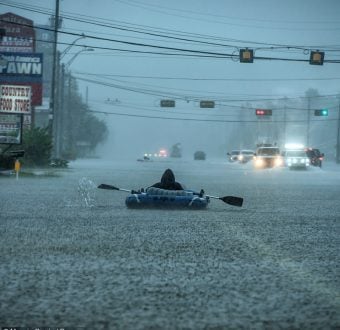It’s been a difficult time to be an activist who was part of the Indigenous-led fight to protect the land and water at Standing Rock. Last week, the Keystone 1 pipeline spilled over 200k gallons of oil in South Dakota onto an agricultural area of Marshall County — and now it’s clear what lengths fossil fuel companies will go to in smearing and trying to stop all those who stand up for our climate or to protect their land and water.
This suit, subsequently filed by ETP under the RICO Act (Racketeer Influenced and Corrupt Organizations Act) — a law used to go after mobsters — asserts that Greenpeace and others willfully directed the #NoDAPL movement with “a network of putative not-for-profits and rogue eco-terrorist groups.” The case also accuses protesters of “perpetrating acts of terrorism” against government property, and other absurd claims like arson and drug trafficking.

Supporters march with Indigenous water protectors from the Standing Rock Nation to demand a halt to the Dakota Access Pipeline.
In a wide-ranging and damning report released last Wednesday, The Intercept confirmed suspicions that Energy Transfer Partners (ETP) hired the private security firm TigerSwan to not only police the Dakota Access Pipeline, but to gather and supply intelligence on Indigenous Water Protectors and climate activists, in an effort to build a conspiracy case against Greenpeace and others.
Paid mercenaries were hired to employ a host of nefarious tactics with the aim of systematically infiltrating resistance groups, and compiling questionable intelligence that could be exploited for future lawsuits. While the lengths that ETP will go to quash peaceful protest may not be surprising, these methods are nevertheless reprehensible.
Military surveillance tactics to hunt protestors
ETP hired mercenaries to utilize a wide swath of military-style counterterrorism tactics, in an effort to undermine the NoDAPL movement, in addition to building its meritless conspiracy lawsuit against Greenpeace.
Here are just a few of the methods they used to build their case against the protestors at Standing Rock:
- Employed paid operatives to infiltrate and surveil protest camps
- Created bogus social media accounts to spy on protesters
- Provided intelligence gained to law enforcement officials
- Tracked details of contributors to the #NoDAPL GoFundMe pages
- Compiled in-depth material on Indigenous and movement leaders
These hostile efforts illustrate the lengths to which private corporations — particularly ETP and other fossil fuel companies — will go to protect their dying industry.

MJ, a young water protector patrolling a camp for security with his horse Champagne.
What is also striking is the breadth of surveillance that ETP devoted to suppressing the legitimate and rightful efforts of pipeline opponents. They’ve shown a clear desire to silence future environmental advocacy and resistance movements that target their corporation.
This is not the first time that a case of this magnitude and similarity has been brought against us. Marc Kasowitz, the longtime personal attorney for Donald Trump, leads the same firm used by Resolute Forest Products that recently sued Greenpeace, using that same RICO Act. Although the case was dismissed in October, Resolute is trying again with an amended filing, highlighting how big corporations will continue to attempt to silence their opponents with these kinds of legal maneuvers.
What does this mean for Greenpeace and resistance efforts in the U.S.?
These tactics aren’t going away; in fact, as the fossil fuel industry gets increasingly nervous about its future we can expect more of these desperate tactics to extend their shelf life. These various surveillance methods are an important reminder of how large, multi-national corporations like ETP will stop at nothing to prevent the people from having our say. We cannot stand down against these disturbing attacks, but must do the exact opposite — we all need to continue (and increase!) our public resistance against forms of oppression that threaten democracy, equality, and our collective future.
We will never back down from this dangerous threat to our fundamental rights of free speech and peaceful protest. Will you also join us in this fight?



